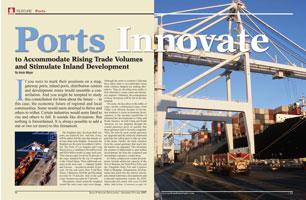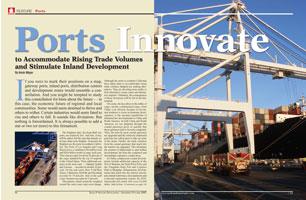
 If you were to mark their positions on a map, gateway ports, inland ports, distribution centers and development zones would resemble a constellation. And you might be tempted to study this constellation for hints about the future — in this case, the economic future of regional and local communities. Some would seem destined to thrive and others to wither. Certain industries would seem fated to rise and others to fall. It sounds like divination. But nothing is foreordained. It is always possible to add a star or two (or more) to this firmament.
If you were to mark their positions on a map, gateway ports, inland ports, distribution centers and development zones would resemble a constellation. And you might be tempted to study this constellation for hints about the future — in this case, the economic future of regional and local communities. Some would seem destined to thrive and others to wither. Certain industries would seem fated to rise and others to fall. It sounds like divination. But nothing is foreordained. It is always possible to add a star or two (or more) to this firmament.
The brightest stars, the deep-draft seaports, are relatively few. And few, if any, will be added. But the ones that already exist may shine more brightly. At present, the brightest are the ports in southern California. The Ports of Los Angeles and Long Beach move a combined 160 million tons and $200 billion worth of cargo each year. This total accounts for about 42 percent of the cargo handled by the top 10 seaports in the United States. Three additional seaports on the west coast — Oakland, Seattle and Tacoma — account for another 20 percent. On the east coast, New York/New Jersey, Charleston, Norfolk and Savannah account for 33 percent. And on the gulf coast, Houston accounts for 5 percent.
This pattern, which is heavily weighted toward the west coast, may soon change. Although the ports in southern California have taken steps to accommodate rising trade volumes, shippers are seeking alternatives. They are diverting more traffic to both alternative ocean routes and alternative seaports. Ultimately, the consequences of these diversions will be felt in the hinterlands.
Of course, the key driver is the influx of cargo, mostly containerized cargo, from China. Less obvious, because of our natural tendency to focus on domestic developments, is the uncanny parallelism of infrastructure developments in China and North America. In both China and North America, we see shipping through the coastal gateways grow so quickly that these gateways start to become congested. Then, the heavily used coastal gateways are upgraded and the relatively underused gateways are called upon to take up some of the strain. Finally, the trade corridors from the coastal gateways that reach into the interior are upgraded. This stimulates the creation of inland hubs to spur further development, far from the congested and increasingly expensive coastal areas.
In China, conspicuous coastal developments include additional capacity at the Port of Shenzen, the Pearl River Ports, and the Yangshan Deep Port and Logistics Park at Shanghai. Infrastructure developments that reach into the interior encompass inland waterways, rail expansions and a national expressway system. By 2020, intermodal rail routes will cover 62,000 miles. And in less than 10 years, the roads of China’s expressway system will cover 40,000 miles.
Substantial distribution networks already serve North America, but they are being upgraded and expanded. And, as in China, the changes are sweeping. On the west coast, shipping will not only continue to pour into the ports of California, it will also flow into the ports of Canada and Mexico. And there are ambitious plans to create north-south commercial corridors that will direct these flows into the United States. And more shipping from Asia will flow to east coast ports via all-water routes, thanks in part to upgrades at the Panama Canal. In 2006, the Panama Canal Authority launched a project to widen and deepen the canal’s two existing channels while adding a third channel. In 2015, when the project is due to be completed, the Panama Canal’s capacity will be doubled. And the canal will be able to accommodate the larger container ships.
It is clear that all these traffic flows — via the west, east and gulf ports — are stimulating various upgrades and expansions of domestic distribution networks. But it is not so clear exactly how these upgrades and expansions might proceed. For example, it is hard to predict the extent to which inland routes might become interconnected. Some experts caution that seaport-to-inland connections might evolve “stovepipe” style, with limited interconnectedness. If this were to happen, distribution networks might offer few choices to exporters. But then leadership at the national level might intervene. Or independent freight carriers might merge. If this were to happen, formerly stove-piped lines could become linked.
Other open questions concern inland ports, or intermodal centers. How many new inland ports might be created? And where, exactly, will they be located? From a network-wide perspective, the exact location of any one intermodal hub might not matter a great deal, provided the hub met the basic requirements, such as proximity to population centers and interstate highways. But at the community level, the presence or absence of an intermodal hub could make the difference between being a boomtown or backwater.
Proliferating Options
The main value of diverse seaports and diverse seaport-to-inland options is the ability to handle the sheer volume of imported cargo. In the United States, ports and waterways already handle more than 2.5 billion tons of trade each year. And this volume is projected to double within the next 15 years. To put this figure in perspective, consider that international trade accounts for a quarter of the nation’s gross domestic product (GDP). By 2020, it may reach as much as a third of the GDP.
But a proliferation of distribution options has benefits besides helping shippers manage volume. It also offers redundancy. With redundancy, disruptions caused by natural disasters, strikes, accidents or security breaches can be minimized. Also, maximizing the waterborne portion of the supply route can offer cost advantages and improve predictability. Leading shippers have already started shifting traffic from landside, west-to-east intermodal links. For example, starting in 2000, Wal-Mart opened new intermodal centers near the ports in Houston, Savannah and Norfolk. Plans to divert traffic ports in southern California include Target, Best Buy, IKEA and Toys “R” Us.
Finally, the balancing of traffic among multiple ports offers yet another benefit. It stimulates the proliferation of inland ports, or intermodal rail hubs. These hubs are fanning out, reaching deeper into the so-called hinterlands. Because these hubs attract distribution centers and development zones, they have the potential to bring communities into the main flow of international commerce.
On this topic, the Wall Street Journal quoted Gil Carmichael, a former administrator of the Federal Railroad Administration and senior chairman of the Intermodal Transportation Institute at the University of Denver, in Colorado. Said Carmichael, “Any community that wants to get into the new industry of this century is going to have [to] be part of this intermodal system. It’s the new industrial park — that’s where you get all the jobs.”*
Improved Port Facilities and Operations
Because coastal seaports may have little room to expand, they often turn to technology to improve operations, moving from “clipboard to keyboard.” They may also resort to extended operations, shifting activities away from peak hours. A prominent example of this approach is the PierPASS program at the Ports of Los Angeles and Long Beach.
Seaports may also elect to deepen the channels that serve them. In the Ports of New York and New Jersey, channels are being deepened to accommodate the larger container ships.
Finally, seaports may find ways to resolve “back-door” issues. To eliminate landside bottlenecks, seaports may improve rail and roadway connections, add truck lanes and build overpasses and tunnels to create grade separations.
International Trans-shipment Hubs and Short Sea Shipping
An international trans-shipment hub is a container port that handles the transfer of containers between feeder and mother vessels. At the trans-shipment hub, cargo is transferred from large “mother” ships onto small “feeder” ships. The feeder ships are sent to smaller, regional ports.
The typical trans-shipment hub is, in a sense, offshore. For example, it has been proposed that trans-shipment hubs in Halifax and at various Caribbean locations could serve east coast ports. A regional port could be a smaller coastal port or an inland port accessible via an inland waterway.
Early examples of short sea shipping in North America include New York’s Port Inland Distribution Network (PIDN) and the private Osprey Line, which serves ports such as Houston, Tampa and Brownsville, TX. Potential sites for wider implementation include the Columbia-Snake River, the Ohio-Mississippi River systems and the Great Lakes system.
Focus on Growth Industries
If a port is struggling to attract traffic or generate revenue, perhaps because it is locked in competition with neighboring ports, one option — albeit a risky option — is to focus on a specialty. One port that took this option was the Port of Seattle. In the late 90s, the Port of Seattle was competing head-to-head with Tacoma, Portland, Vancouver and Los Angeles, vying for shipments of petroleum, break-bulk and containerized cargo from Asia. The Port of Seattle struggled to generate revenue. Even worse, the fishing industry was in decline and expansion was not an option.
In response, the Port of Seattle deliberately scaled back its break-bulk and containerized operations while renovating terminal space to accommodate cruise liners. Total volume fell, but income and employment eventually rose. Today the Port of Seattle, directly or indirectly, accounts for about 35,000 jobs in the region.
Widening the Arc of Inland Ports
Inland ports, also called intermodal yards or rail hubs, already ring major population centers. But with increased trade volume and suburban residential development reaching ever further into the hinterlands, options to expand existing hubs or creating new hubs may be limited. Near population centers, real estate is becoming more expensive and residents are less tolerant of noise and pollution. New hubs may have to be placed along arcs farther and farther from population centers. But shippers will still prefer sites close to major highways. And they will try to keep inland ports at least 50 miles apart. Otherwise, rail transport loses its cost advantage.
According to logistics consultant IMS Worldwide, hot inland ports include the following:
Chicago, IL, Columbus, OH, Dallas, TX, Front Royal, VA, Harrisburg, PA, Inland Empire, CA, Kansas City, MO and Memphis, TN.
Wrapping Up
The improvements, expansions and reconfigurations summarized in this article are happening now, despite their expense and the added complications of meeting security and environmental requirements. In many cases, authorities are arranging the necessary investments via private-public partnerships. Often, public ownership and oversight is combined with private investment and management. In this model, which is still being refined, the granting of consignments is often a key link.
Although security and environmental programs often require additional funds, they sometimes produce unanticipated benefits. For example, U.S. Ambassador Charles P. Ries spoke of the business advantages of the U.S. Coast Guard’s International Ship and Port Security Code. According to Ries, “As ports around the world have worked to meet the standards of the Code, U.S. Coast Guard officials have increasingly heard about the unintended, but highly desirable, secondary effects on port operations. Facilities are less crowded because people who don’t belong on the docks are no longer on the docks; theft losses are way down; there are fewer incidents of stowaways; port and maritime employees are more accountable; and communications between ships and port facilities have been greatly improved.”
